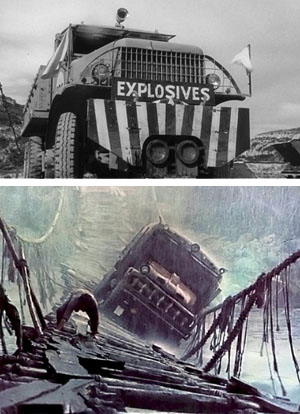Several times per year, there is a burst of complaint on the Internet, usually spurred by a studio announcing that it will remake some favorite classic or another. There is usually wailing and gnashing and lamenting that the new film will undeniably be a pale shadow of its namesake. And every time, I have to remind everyone that remakes aren’t necessarily evil.
The Wizard of Oz — the one with Judy Garland and “Somewhere Over the Rainbow” — is a remake. The Maltese Falcon — the one with Humphrey Bogart and Peter Lorre — is a remake. A Bug’s Life, The Magnificent Seven, and Battle Beyond the Stars are all loose remakes of the same movie. Hell, Star Wars wouldn’t exist without Hidden Fortress. Alfred Hitchcock even remade his own films.
The reason remakes have a bad reputation is because they are often produced as marketing tools first and films later: a remake often enters a theater with automatic name recognition. However, sometimes, the right talent gets involved, and the result is a second movie that is decent in its own right.
Today, I’ll talk about a great pair of movies: The Wages of Fear (1953) and Sorcerer (1977).
The Wages of Fear has long been one of my favorite films. It’s a French thriller from one of my favorite directors of all time, Henri-Georges Clouzot (who is also the guy behind Diabolique (1955)). The film is a master class in creating and maintaining tension: it picks a strong, simple premise, and then milks every possible bead of sweat out of it. The entire point of the movie is white-knuckle tension.
The Wages of Fear begins in a poor South American village, where four men of different nationalities are down on their luck. Their luck turns when an oil well ignites, and the only way to extinguish the fire and cap the well is to blow it up with nitroglycerin. Since the stash of incredibly volatile nitroglycerin is on the other side of the mountains, the oil company offers top dollar to anyone who is willing to drive two trucks full of nitro over crumbling roads to the oil fire. The four foreigners take the job. The rest of the film involves these four guys driving veeeeeerrrrry sloooooooowwwwly.
The description may not seem like much, but you’d be amazed how much cinematic mileage (heh) you can get out of two very carefully-driven trucks. On the surface, the film is very simple, but the inner workings are like that of a Swiss watch: delicate, intricate, and perfectly timed.
Given that The Wages of Fear makes the best of a slow burn of tension, you’d naturally think that a 1970’s American remake would break the hell out of everything that makes it work, right?
Well.
Once upon a time, there was this youngish director named William Friedkin. He directed some stuff in the late 1960s, but his fame erupted when he directed a 1971 thriller called The French Connection. His next film was something called The Exorcist, which terrified the pants off of pretty much everybody. His follow-up to The Exorcist was to be a straight-up remake of The Wages of Fear.
The production of Sorcerer is somewhat legendary for being expensive and problematic. A single scene, involving a truck crossing a bridge, took over three months to shoot and ate up a huge portion of the film’s budget. Then, once the film was completed, it had the misfortune to be released on June 24, 1977 — a couple of weeks after a movie called Star Wars. Sorcerer flopped horribly and vanished.
Yet Sorcerer is pretty great in its own right. I had my own doubts before seeing it myself, since it couldn’t possibly reach for The Wages of Fear, right? But I loved the hell out of Sorcerer. Part of the reason I love it is this: Sorcerer and The Wages of Fear share the exact same plot, but use different tactics to tell the same story. They are wonderful companions to each other.
The Wages of Fear wrests its tension out of its premise. It sets up its characters with great efficiency, and then BOOM, we are in the mountains with the trucks. Sorcerer, instead, uses half of its running time establishing its characters. By the time we reach the bit with the trucks, we are invested in the safety of the drivers.
Sorcerer also wins points for being grimier and feeling larger in scope than the previous film. It also helps that one of the drivers in Sorcerer is Jaws-era Roy Scheider, who I find immensely watchable.
I also like the ending of Sorcerer better than the ending of The Wages of Fear. Both endings have the same tone, and each film has the right ending for the story it is telling, but the ending of Sorcerer is more satisfying.
If you have seen only one or neither film before, I encourage you to see both out. These films stand as proof that remakes can actually be a worthwhile endeavors.





